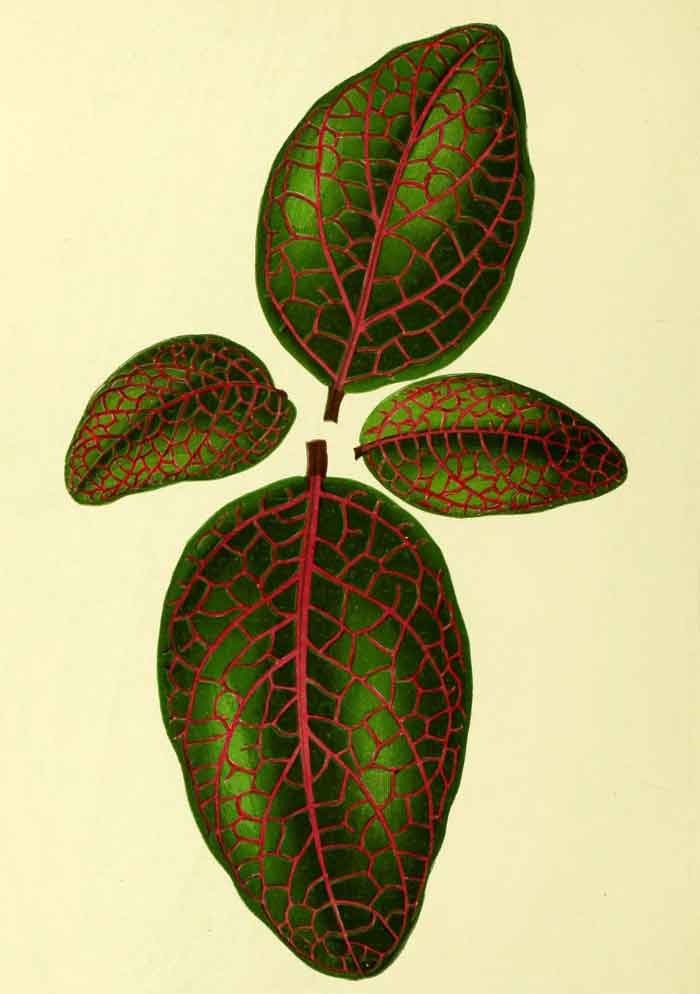
Classification System: APG IV
Superregnum: Eukaryota
Regnum: Plantae
Cladus: Angiosperms
Cladus: Eudicots
Cladus: Core eudicots
Cladus: Asterids
Cladus: Lamiids
Ordo: Lamiales
Familia: Acanthaceae
Subfamilia: Acanthoideae
Tribus: Justicieae
Subtribus: Tetrameriinae
Genus: Fittonia
Species: Fittonia albivenis
Name
Fittonia albivenis (Lindl. ex Veitch) Brummitt, 1979.
Synonyms
Basionym
Adelaster albivenis Lindl. ex Veitch, Gard. Chron. 1861: 499. 1861.
Heterotypic
Fittonia argyroneura Coem., Ann. Gén. Hort. 16: 103–104, t. 1664. 1867.
Eranthemum verschaffeltii (Lem.) Hort., Vilm. Blumengärtn., ed. 3. 1: 812. 1895, nom. inval.
Fittonia verschaffeltii (Lem.) Van Houtte, Fl. des Serres 15: 186. 1865.
Fittonia verschaffeltii f. argyroneura (Coem.) Voss, Blumengirtnerei (Vilmorin), ed. 3: 812. (1894
Fittonia verschaffeltii var. argyroneura (Coem.) Regel, Gartenflora 18:259. 1869.
Gymnostachyum argyroneurum (Coem.) Verschaff., Cat. Pl. Jean Verschaffelt 11: 3, 12. 1868.
Gymnostachyum verschaffeltii Lem., Ill. Hort. 10: t. 372. 1863.
Distribution
Native distribution areas:
Continental: Southern America
Regional: Western South America
Bolivia, Ecuador, Peru
Regional: Brazil
Brazil North
Regional: Northern South America
Colombia, Venezuela
Introduced into:
Bangladesh, El Salvador, Marianas, Myanmar, Trinidad-Tobago
References: Brummitt, R.K. 2001. TDWG – World Geographical Scheme for Recording Plant Distributions, 2nd Edition
References
Primary references
Brummitt, R.K. 1979. Botanical Magazine; or, Flower-Garden Displayed ... London 182:165, t. 788.
Additional references
Brako, L. & Zarucchi, J.L. 1993. Catalogue of the Flowering Plants and Gymnosperms of Peru. Monogr. Syst. Bot. Missouri Bot. Gard. 45: i–xl, 1–1286.
Jørgensen, P.M. & León-Yánez, S. 1999. Catalogue of the vascular plants of Ecuador. Monogr. Syst. Bot. Missouri Bot. Gard. 75: iviii,.
Renner, S.S., Balslev, H. & Holm-Nielsen, L.B. 1990. Flowering plants of Amazonian Ecuador—A checklist. AAU Rep. 24: 1–241.
Links
Govaerts, R. et al. 2022. Fittonia albivenis in Kew Science Plants of the World Online. The Board of Trustees of the Royal Botanic Gardens, Kew. Published online. Accessed: 2022 November 06. Reference page.
Hassler, M. 2022. Fittonia albivenis. World Plants: Synonymic Checklists of the Vascular Plants of the World In: Roskovh, Y., Abucay, L., Orrell, T., Nicolson, D., Bailly, N., Kirk, P., Bourgoin, T., DeWalt, R.E., Decock, W., De Wever, A., Nieukerken, E. van, Zarucchi, J. & Penev, L., eds. 2022. Species 2000 & ITIS Catalogue of Life. Published online. Accessed: 2022 November 06. Reference page.
Tropicos.org 2022. Fittonia albivenis. Missouri Botanical Garden. Published online. Accessed: 06 November 2022.
International Plant Names Index. 2022. Fittonia albivenis. Published online. Accessed: November 06 2022.
USDA, ARS, Germplasm Resources Information Network. Fittonia albivenis in the Germplasm Resources Information Network (GRIN), U.S. Department of Agriculture Agricultural Research Service. Accessed: 07-Oct-06.
Vernacular names
فارسی: فيتونيا البيفينيس
magyar: Piroserű hálóslevél
polski: Fitonia białożyłkowa
русский: Фиттония беложильчатая
svenska: Åderblad
українська: Фіттонія
中文: 嫣红蔓, 网纹草
Fittonia albivenis is a species of flowering plant in the family Acanthaceae, native to the rainforests of Colombia, Peru, Bolivia, Ecuador and northern Brazil. An evergreen perennial, it is notable for its dark green foliage with strongly contrasting white or red veins. It is commonly called nerve plant or mosaic plant. In temperate regions where the temperature falls below 10 °C (50 °F) it must be grown as a houseplant.[2]
Description
Inflorescence
Fittonia albivenis is a creeping evergreen perennial growing to 15 cm (6 in) high, with lush green, ovate leaves, 7 to 10 cm long, with accented veins of white to deep pink and a short fuzz covering its stems. Small buds may appear after time where the stem splits into leaves. There are also forms in which the nervatura is carmine-red. Flowers are small with a white to off-white color.[3]
Leaf detail, showing the prominent white veins
Cultivation
The species is used as an ornamental plant that requires fertile soils or substrates based on peat.[1] It is best kept in a moist area with mild sunlight, although it does not demand much light, and temperatures above 55 °F (13 °C). As such, in temperate locations it must be kept under glass as a houseplant.[citation needed]
It must be watered regularly. Without water for a few days, it is known to "faint" but is easily revived with a quick watering and resumes its healthiness. Fittonia albivenis is known to be hard to grow, so it is best bought at a nursery then cared for. Its spreading habit makes it ideal as groundcover.[citation needed]
Numerous cultivars have been selected, falling into two cultivar groups, the Argyroneura Group (formerly F. argyroneura, F. verschaffeltii var. argyroneura) with silver to white veins,[4] and the Verschaffeltii Group (formerly F. verschaffeltii) with pink to red veins,[5] both of which have gained the Royal Horticultural Society's Award of Garden Merit.[6]
Uses
The Kofan, Siona and Secoya tribes of the Ecuadorian Amazon use F. albivenis as a treatment for headaches,[7] and muscular pain, its leaves were used by the Machiguenga as a hallucinogen before they were introduced to Psychotria viridis.[8] They are said to "produce visions of eyeballs." The leaves of this species are prepared as a tea in the northwestern part of the Amazon region and used for toothache.[7]
See also
Psychedelic plants
References
"Fittonia albivenis". Germplasm Resources Information Network. Agricultural Research Service, United States Department of Agriculture. Retrieved 2008-02-25.
RHS A-Z encyclopedia of garden plants. United Kingdom: Dorling Kindersley. 2008. p. 1136. ISBN 978-1405332965.
Rob Herwig: Parey's Houseplant Encyclopedia . Edited by Richard Maatsch. Parey, Berlin / Hamburg 1983. ISBN 3-489-61024-5
"RHS Plant Selector - Fittonia albivenis Argyroneura Group". Retrieved 4 July 2020.
"RHS Plantfinder - Fittonia albivensis Verschaffeltii Group". Retrieved 27 February 2018.
"AGM Plants - Ornamental" (PDF). Royal Horticultural Society. July 2017. p. 39. Retrieved 27 February 2018.
"Plants". manu.montana.com. Retrieved 2008-02-25.
Russo, Ethan B. "Headace treatments by native peoples of the Ecuadorian Amazon". Universidad del Museo Social Argentino. Archived from the original on 2013-06-16. Retrieved 2013-05-19.
Retrieved from "http://en.wikipedia.org/"
All text is available under the terms of the GNU Free Documentation License

